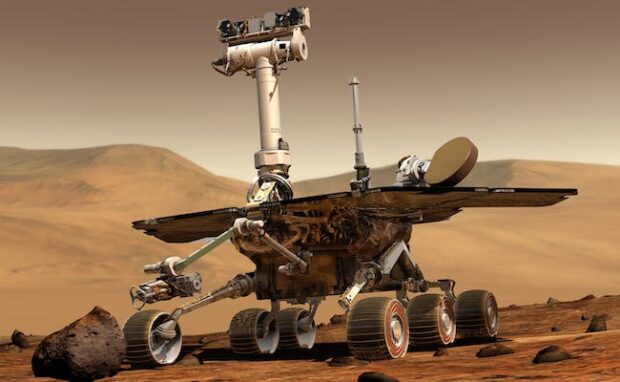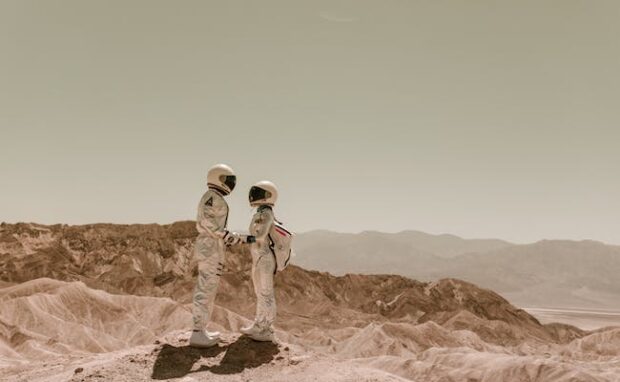Chinese lander detects giant polygons buried beneath Mars
In its latest scans, Chinese lander Zhurong revealed irregular polygonal wedges beneath Mars’ surface. Scientists believe the buried shapes resulted from water freezing and thawing billions of years ago. On the other hand, they could also be from cooling lava flows. Both possibilities could reveal more insights about the Red Planet.
If those polygonal structures came from water freezing and thawing, that could mean the planet had oceans like Earth’s. Consequently, it might increase the likelihood of finding life on Mars, such as microscopic organisms. Also, future space missions might find water on the Red Planet, facilitating longer surface explorations.
This article will discuss the latest discovery from China’s lander Zhurong. Later, I will share more scientific breakthroughs related to the Red Planet.
What did the Chinese lander find on Mars?

Zhurong’s ground-penetrating radar detected irregular polygonal wedges located at a depth of roughly 35 meters on Utopia Planitia. It is a large plain within Utopia, the largest recognized impact basin on Mars and our solar system.
It has an estimated diameter of 3,300 km, and the rover traveled 1,921 meters during its lifetime. The Chinese lander explored its landing site, sent back images, studied the topography of Mars, and conducted measurements with its ground-penetrating radar.
Scientists believe these buried shapes came from Mars’ freeze-thaw cycles. On the other hand, they could have originated from cooling lava flows.
They also think these features formed 3.7 to 2.9 billion years ago during the Red Planet’s Late Hesperian-Early Amazonian epochs, “possibly with the cessation of an ancient wet environment.”
ScienceAlert said palaeo-polygonal terrain, either with or without being eroded, was subsequently buried” by later geological processes. Previous missions have found other polygon-type terrain, but Zhurong’s discovery is the first time we’ve seen them buried.
Lei Zhang and colleagues led research into the lander’s findings, wrote a paper, and published it in Nature. Universe Today said it shared more insights about the formation’s probable origins:
You may also like: Why does my computer keep freezing?
“The possible presence of water and ice required for the freeze-thaw process in the wedges may have come from cryogenic suction-induced moisture migration from an underground aquifer on Mars, snowfall from the air, or vapor diffusion for pore ice deposition,” the paper explained.
“The subsurface structure with the covering materials overlying the buried palaeo-polygonal terrain suggests that there was a notable palaeoclimatic transformation sometime thereafter,” the researchers wrote.
“The contrast above and below about-35-meter depth represented a notable transformation of water activity or thermal conditions in ancient Martian time, implying that there was a climatic upheaval at low-to-mid latitudes.”
Other recent planetary discoveries

NASA and other space agencies have been studying the possibility of living on Mars. However, how many people would we need? Past studies say we need 100 to 500 astronauts because it will be an “incredibly complex engineering problem.”
The Red Planet is inhospitable, so a Mars colony must protect people from its harsh conditions. For example, it must provide enough oxygen and shield against radiation.
The news outlet says a space colony could separate hydrogen atoms in Martian water to create breathable air and viable fuel. Moreover, the settlers must mine minerals to produce other necessities.
However, new research from George Mason University discovered a Mars colony may only need 22 to function. They derived a lower estimate after factoring in psychological factors.
Edgar Arguello and his colleagues analyzed previous data on high-performing teams in isolated and high-stress environments. These included submarine crews, Arctic explorers, and international space station scientists.
The GMU scientists ran an Agent-Based Modeling computer simulation to analyze complicated systems and predict larger patterns. Also, they created models for Martian settlers with different factors like resilience, skills, and metabolism.
Each model has one of four psychological traits: agreeable, social, reactive, and neurotic. Then, they used ABM to simulate human survival on Mars under different working conditions.
You may also like: Perseverance Mars rover makes oxygen on another planet
For example, they tested how a Mars colony would respond to delays in Earth resupplies. Moreover, the colonist models could have deteriorating health and die without enough resources.
The GMU researchers had five trials lasting 28 years, with population sizes ranging from 10 to 170. As a result, they discovered that “an initial population of 22 was the minimum required to maintain a viable colony size over the long run.”
They also concluded the “agreeable” personality type characterized by great empathy was more likely to survive in a Mars colony. Conversely, “neurotic” people died faster.
Conclusion
The Chinese lander Zhurong detected irregular polygons under Mars’ surface. That implies that the Red Planet may have had water freeze and thaw on its surface billions of years ago.
That boosts the possibility of finding life on Mars. After all, water is one of the basic building blocks of life. Also, the planet may have hidden water for future Martian colonies.
Learn more about the latest discovery of the Chinese rover on the Nature webpage. Also, check out more digital tips and trends at Inquirer Tech.